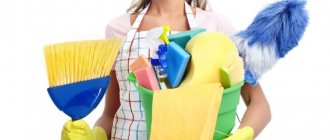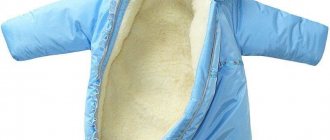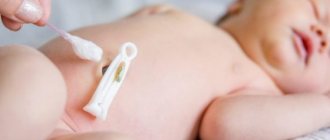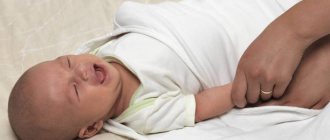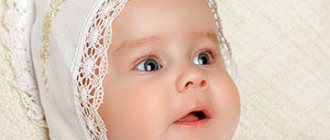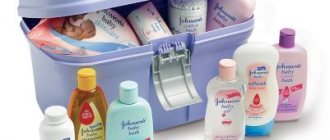Preparing to welcome your baby home
You need to take care of your baby’s comfort at home even before he is born. Even if you are superstitious and against shopping for your baby in advance, there should be a minimum set for your arrival. Believe me: in the first days at home with a small child in your arms, you will definitely not have time to buy “little men” and onesies.
Equip your children's room
If this is not possible, then organize a place for the newborn in your room. This should be a calm corner. The main thing is the optimal level of humidity (40 - 60%), temperature (18 - 20 degrees), the absence of drafts and radiators near the crib.
If your apartment has dry air, be sure to purchase a humidifier - insufficient humidity in the room is very harmful for babies. Ventilate the room regularly.
Daily wet cleaning of the room is required. But do not strive for sterility - it is of no use. The child must get used to the microflora of his home and family members - this is how he develops immunity.
Make yourself comfortable
What should the temperature be in the nursery?
From 18 to 22°C. Install a thermometer in your baby's room and monitor its readings. Very young children are very sensitive to external conditions, and especially to temperature changes. Be careful!
What about air humidity?
From 50 to 60%. The most common problem is too dry air in the nursery. If you are faced with this situation, try to quickly correct the situation (using special humidifiers or tried-and-true “grandmother’s” remedies like a basin of water). The fact is that dry air disrupts the baby's breathing, drying out the mucous membranes.
Where is the best place to put a crib?
Away from windows, radiators, heaters. It is very important to protect the little one from drafts and overheating. By the way, if you want to heat the air in the nursery, use only closed oil heaters, they are safe and do not burn oxygen.
What to do with a newborn at home?
As soon as you arrive home from the maternity hospital, relax with your baby. Take a shower and get a good night's sleep.
It’s a big mistake to gather all your relatives and have a feast on the day of discharge. After being discharged from the hospital, mother and child need rest to gain strength.
Organize a place where you will change your baby's diapers, change clothes, wash your baby - care after discharge will take up almost your time. Therefore, prepare in advance the place where you will care for the baby, place accessories on it - this way you will save time and effort.
Rules for caring for a newborn
It seems to an inexperienced mother that caring for a baby is an incomprehensible science. The first few days at home you will have to learn a lot, but experience comes quickly. Here are some recommendations for caring for your child after discharge:
Change diapers - every 3 hours
Even if it seems to you that the diaper is not yet full, change it anyway. If you just changed a diaper and your baby immediately poops in it, change it right away. You need to remove the diaper from front to back.
Clean your ears - every day
For the first time after discharge, use cotton wool balls and Vaseline oil to care for your ears. Dip the ball a little in a small amount of oil and gently and shallowly clean the ears. There is no need to clean the ear canal to avoid injury.
Rinse your nose morning and evening
You will need a Humera-type saline solution, sea buckthorn oil, cotton wool, and a pipette. Make flagella from cotton wool.
Place 2 drops of solution into each nasal passage. Wait a little, then dip the flagellum in oil and insert it into the nostril with a twisting motion - this will remove the crusts and make breathing easier.
Treat your navel several times a day
At the maternity hospital they will tell you how to care for her. First, thoroughly moisten a cotton swab with hydrogen peroxide and carefully treat the navel, then lubricate it with brilliant green. Baneocin powder also dries the wound perfectly - you need to sprinkle it on the wound in the morning and evening. Take care of your navel responsibly: do not let the wound get wet, make sure that the edge of the diaper does not cover the navel. Otherwise, it will take much longer to heal.
Trim your nails as they grow.
On the toes it is enough to do this even once a week, but on the hands you will have to cut it more often - children’s nails grow very quickly. The safest way to do this is with children's scissors. Do not try to cut the nails along the edges of the roller - they can grow in, the skin will become inflamed, and you will have to take the baby to a podiatrist. You need to cut in a straight line.
Wash your face every morning
Soak a cotton pad in warm boiled water and wipe the eyes - from the outer to the inner corner. A new disc for each eye. Use a separate disc to wipe the face, behind the ears, and neck.
Intimate care for son and daughter
After each diaper change, the baby should be washed. Regular tap water is suitable for this. There are rules for washing:
Boys - from the bottom forward. To do this, bring your son to the sink, press his tummy to you and wash him. Do not pull or move the skin on the penis;
For girls, from the front to the butt. And nothing else! Do not allow dirt to get into the baby's genitals. Especially after defecation. Make sure that everything between the labia and the folds of the legs is clean.
After this, pat your body dry with a soft diaper and apply diaper cream or powder to the bottom, put on a diaper. Oil is not suitable for these purposes because it does not allow the skin to breathe.
Newborn hygiene
Daily cleansing of the nose, eyes, and ears can be considered an excess if there is no discharge from them, the child is healthy and nothing bothers him.
To protect the nasal mucosa, nature has endowed humans and their offspring with a sneezing reflex. Therefore, sneezing is a completely natural mechanism for cleansing the nasal cavity, and the child has the right to this.
To protect the eyes, there is tear fluid, which is evacuated into the nasal cavity. No additional steps are required to clean the baby's eyes!
Earwax protects the external auditory canal. The use of cotton swabs to clean it is strictly prohibited!
Conclusion: we don’t touch babies’ natural orifices unnecessarily.
How to bathe a baby
On the first day of discharge from the maternity hospital, you should not bathe the baby. This may cause additional stress for him. Simply wash and rinse off. But the next day you can begin full-fledged water procedures.
They are usually carried out in the evening before feeding, so that the baby can then fall asleep peacefully. But this rule does not work for everyone. Perhaps the ideal time for bathing for your child will be morning or lunchtime - experiment.
Bathing accessories
You will need:
- Bath - the most ordinary one will do, because in a few months you will switch to a regular bathroom;
- Herbs - string, celandine. The herb is brewed in a glass of water and added to the bath;
- Bathing product - gel, milk, cream. It should be marked “0+”. For very small children, using it once a week is enough.
The baby needs to be bathed daily in boiled water until the umbilical wound heals. This will take about a month. After this, you don’t have to boil the water.
The room where you perform bath procedures should be warm. The most convenient place to bathe is in the kitchen - you can put the bath on the table. This reduces the load on the parents' backs.
Bathing Tips
The optimal water temperature is 37 degrees. Check with a water thermometer. If your child screams when lowered into the bath, the water may be too cold for him - try adding warm water.
Bathe your baby for 10 to 15 minutes in the first days after being discharged from the hospital.
It is better for mom and dad to bathe the newborn together. For example, dad holds him under the head with one hand and under the butt with the other. Mom is washing at this time.
Some parents are terrified of getting their child's ears wet while bathing. Grandmothers often “sin” with this. In fact, nothing bad will happen, because for all 9 months your child has been in the water, including his ears. The main thing is to dry them thoroughly with a towel or sheet and put on a hat.
After the procedure, immediately wrap the baby in a towel, pat dry and put on clean clothes.
How to organize the process of natural and artificial feeding?
The best food for a baby is breast milk. However, situations are different, sometimes parents have to make a choice in favor of mixed or artificial nutrition for the newborn.
Pediatrician Polina Kizino tells how to properly organize this or that type of feeding: “If the baby is on the breast, feeding on demand is recommended. During the newborn period, the more often the baby is put to the breast, the better. Thus, lactation is stimulated. But, nevertheless, by the end of the first month of life, it is advisable to establish a more or less understandable regime. This means we don't wait until the three hours are up if the baby is hungry, but we also don't feed him every 30 minutes.
This applies to breastfeeding. If we talk about feeding exclusively with formulas, then feeding is carried out once every three hours or less - this issue is resolved with the pediatrician observing the child.”
Note that when choosing a formula for artificial feeding, you must consult a doctor, and then observe how the baby reacts to nutrition.
However, for a newborn’s digestion, changing formula is stressful, so it’s better to immediately choose a reliable option that you won’t have to change. This should be a mixture that excludes all possible “what if...”, that is, it is suitable for children prone to allergies, children with sensitive digestion, and babies with lactase deficiency, it should be easily digestible and tasty.
The modern goat milk infant formula Kabrita meets these criteria.
Even the most picky children do not refuse this mixture. The secret is in the creamy taste, adapted protein composition and a unique complex of fats, prebiotics and probiotics. Kabrita formulas are as close in composition as possible to breast milk, therefore they normalize the baby’s digestion and contribute to the correct and harmonious development of the baby.
Feeding a newborn
In this article, we will not touch upon the issues of breastfeeding and artificial feeding, since this is a very broad topic. Let's talk only about the most important points.
First, you need to feed your baby every 3 hours. He can sleep longer - be sure to wake him up! Offer the breast or bottle even if he is sleeping. This is especially true for night feedings: the baby can sleep half the night through, and the mother is happy that he is so calm and well-fed. In fact, this is a very dangerous misconception: if the baby is hungry, he may fall asleep even more deeply instead of crying and calling his mother. Therefore, feeding every 3 hours is a must!
Secondly, hold your baby in a “pillar” position after each feeding. This will allow him to burp the air that he swallows while eating, and he will not have a tummy ache.
Third, support the baby's head while feeding. For example, place it on the crook of your elbow. This is necessary so that the baby does not choke.
Early breastfeeding
In recent years, almost all maternity hospitals in our country have practiced early attachment of the baby to the mother's breast, with the exception of those rare cases when there are contraindications on the part of the mother or baby. The first sensations from contact “skin to skin”, “eye to eye” are necessary for both mother and her baby. It is believed that the sucking process promotes early contraction of the uterus and faster separation of the placenta, as well as reducing the degree of blood loss in the mother. The baby at his mother’s breast feels loved and more protected in the new world. He develops a strong and long-term attachment to his mother. The mother, in turn, calms down faster after all the worries when she sees that the birth process went well for the child. This promotes the manifestation of maternal instinct and faster formation of breast milk.
So, the doctors present at the birth will decide immediately after the birth of your baby whether it is possible to put him to the breast. First, he will be dried with a warm diaper and placed naked on the mother's stomach to quickly examine and rule out diseases that require immediate medical attention.
First walk outside
Modern pediatricians recommend going for a walk almost immediately after being discharged from the hospital. Provided that the baby is healthy and the weather is good outside, you can go out the next day.
It’s worth holding off on walks if:
- There are contraindications due to the health of the newborn;
- It is very hot outside or, conversely, frost, strong wind, rain, fog.
In this case, you can place the stroller with the baby on the balcony or in front of an open window. Make sure there is no draft.
How long to walk? For the first exercise, 15-20 minutes is enough, and soon walk for 2 hours or longer. You will quickly develop a walking routine, because after 3 hours the baby will need to be fed, remember?
How to avoid freezing a child?
You have arrived home, where a corner has already been prepared for the child, all his things are laid out - diapers, clothes, nappies and care products. There should be no drafts in the room, but at the same time it is better to maintain the air temperature at 22-24 degrees
Celsius. To do this, ventilate the room regularly, but try not to use heaters. They dry out the air, and it becomes uncomfortable for the baby’s delicate nasopharynx mucosa. You can check if your baby is cold by touching the tip of his nose or forearm. If these places are not cold to the touch, the child is quite comfortable. Make sure that your newborn's clothes do not become wet, and that beads of sweat do not appear on the tip of the nose - these are signs that the baby is hot.
Features of defecation in children
Young parents are often frightened by the appearance of the contents of diapers. But in most cases there is no cause for concern, especially if you are breastfeeding.
Firstly, babies from birth to several months walk very often.
Secondly, very loose stools are the absolute norm. Only some time after the introduction of complementary foods will it begin to take on some form.
Thirdly, the color of stool can be anything: yellow, brown, greenish, have a sour smell, and contain a little mucus. But there should be no blood or foam in children’s feces. This is a reason to call your pediatrician.
Other physiological conditions
At first, after being discharged from the hospital, you may be frightened by some of the things that happen to the baby.
Rashes, pimples and redness of the skin. Such manifestations are possible in the first two weeks after discharge. Peeling may also appear. This is due to the fact that the baby was in the water for all 9 months, and now he suddenly found himself in the air. He needs time to adapt to new living conditions. And after 2 - 4 weeks, acne will appear. This condition is also called flowering, and it does not require any special treatment or care. This is how the mother’s hormones are destroyed in the baby’s body.
Another consequence of hormonal changes in the baby is the enlargement of the nipples, especially in girls. This is also safe and goes away on its own.
Temperature surges. Newly born babies do not yet have full thermoregulation. The norm is from 36.5 to 37.5 degrees. What to do if the temperature:
- low - perhaps the baby is cold: dress him warmer;
- increased - if there is no runny nose or cough, most likely the problem is overheating and you need to undress the baby. If there are signs of a cold, contact your pediatrician.
Children are characterized by a rise in temperature up to 38 degrees. Therefore, in maternity hospitals, mothers are recommended to measure it every day. But do not measure it after sleeping or crying - the indicators will be overestimated.
Borderline conditions of a newborn
Borderline or transient conditions in newborns are temporary symptoms that arise in connection with the adaptation of a small organism. These conditions do not require special treatment. As a rule, by the end of the newborn period, that is, by the 28th day of the baby’s life, everything passes without a trace.
These include:
Physiological weight loss
The baby’s body weight decreases due to the baby’s adjustment to a new type of nutrition. When leaving the aquatic environment “on land,” there is a kind of deficiency of milk and water in the first day. The baby also passes the original feces (meconium), and the remainder of the umbilical cord dries out.
To replenish energy costs, in the first days the newborn’s body uses its own depot of special brown fat, which is concentrated in the neck, kidneys, and upper back. The loss of body weight should not exceed 6-10% of the initial weight at birth.
After 3-4 days of life, the baby begins to gain weight (from 10 to 50 g per day). By the 12th day, a healthy baby should regain the lost weight.
Erythema toxicum
Occurs most often 3-5 days after birth. It is a pink spotty rash with yellow lumps in the center. Elements of the rash can be of different sizes: from pinpoint to centimeter, they do not itch.
The rash appears most often on the chest, face, and on the extensor surfaces of large joints and around them (elbows, shoulders, knees). At the same time, nothing bothers the baby, his well-being does not suffer.
This condition occurs due to the penetration into the blood of toxins of microorganisms that the baby has encountered during this time. These even include opportunistic bacteria that colonized the baby’s intestines in the first days of life.
As a rule, erythema toxicum occurs more often in children who have a hereditary predisposition to allergies.
This condition usually does not require treatment. If the process is severe, it is recommended to increase the baby’s drinking regime and sometimes prescribe antihistamines (anti-allergic) drugs. Normally, the rash disappears after 2-3 days.
Other transient skin manifestations
- The bright red coloring of a newborn's skin is a peculiar reaction to irritants (removal of birth lubricant, dry air, unusually low ambient temperature).
- Large-plate peeling of the skin in newborns is observed due to a change in environment and excessive evaporation of moisture from the skin. It appears on almost all parts of the body, but is more pronounced on the stomach, legs and feet.
- Milia are small white dots on the back and wings of the nose, on the chin of a newborn. The cause of this condition is blockage of the sebaceous glands. By the 2-3rd week of life, the ducts of the sebaceous glands open, and the milia gradually disappear.
- Increased pigmentation (darkening) of the skin around the nipples and scrotum in boys is a manifestation of hormonal changes in the baby’s body. These changes are associated with a massive release of female sex hormones during childbirth by the mother. The dark coloration of the skin disappears without any treatment by the 3rd week of the baby’s life.
- Telangiectasias are crimson spots in the occipital fossa, on the forehead and in the bridge of the baby’s nose. They represent an expanded network of capillaries (spider veins). This manifestation is popularly called the “stork mark.” Telangiectasias gradually fade and disappear by one year.
Useful: How do experienced mothers choose diapers: what to pay attention to?
Sexual (hormonal) crisis
The cause of this condition is the high level of female sex hormones in the last days of pregnancy and at the time of birth and their effect on the body of the newborn.
This appears:
- engorgement of the mammary glands, enlargement and thickening of them for 3-5 days. Sometimes even a light sticky secretion (colostrum) is released from the gland. Within a week everything goes away without any treatment;
- enlargement due to swelling of the labia majora and minora, clitoris in girls, scrotum in boys;
- the release of abundant mucous secretion of a grayish-whitish color from the genital slit in 60-70% of girls. Sometimes bloody discharge (metrorrhagia) appears. As a rule, they disappear after a few days.
Physiological jaundice
Jaundice staining of the skin, sclera and mucous membranes appears on the 2-3rd day of the baby’s life. The color intensity reaches a maximum on the 4-6th day, and disappears by the 7-10th day. The baby feels good.
The cause of this condition is the breakdown of a large amount of fetal hemoglobin in the erythrocytes (red blood cells) of the newborn. This is a natural process of replacing fetal hemoglobin with new “adult” hemoglobin. At the same time, the breakdown product of red blood cells, free bilirubin, is released into the blood, which must be utilized by the liver.
But the low enzymatic activity of the immature liver of a newborn does not allow this to be done in a short time. The level of bilirubin in the blood of a newborn ranges from 26-34 to 130-170 µmol/l.
Premature babies develop this condition more often and last longer. Also, the manifestations of jaundice are more pronounced in babies who started breastfeeding late or when their mother has a lack of milk.
It is necessary to strictly monitor the time of appearance and increase in intensity of jaundiced skin coloring, since jaundice is not physiological. For example, in case of Rh conflict between the blood of mother and baby, when the mother has Rh-negative blood and the baby has Rh-positive blood.
Transient disturbances of thermoregulation (hyperthermia and hypothermia)
Immediately after birth, the newborn’s body temperature decreases compensatoryly in response to the lower ambient temperature and the evaporation of moisture from the skin.
Therefore, to prevent even greater heat loss, the temperature in the maternity rooms is maintained at no lower than 24°C; the newborn is placed on a heated table for examination, then wrapped in warm diapers. During the first day of life, the child's temperature is within normal limits.
By the 3-5th day of a baby’s life, his body temperature can rise to 38.5°C. The reason for this is the immaturity of the thermoregulation centers of the newborn’s brain, adaptation to dry air with variable temperatures. The child suffers large losses of fluid through breathing. In addition, the mother produces a small amount of milk in the first days of lactation.
Transient neurological symptoms
Periodic flinching, inconsistent squinting, slight trembling of the chin when screaming, differences in muscle tone on the left and right sides, instability of muscle tone and reflexes, painful crying or screaming - all this is considered normal in the first weeks of a baby’s life.
It's all due to the immaturity of the newborn's brain. In addition, at the time of birth, the baby experiences an acute lack of oxygen.
There is a so-called imbalance in the processes of excitation and inhibition in the baby’s nervous system. Therefore, he needs time to adjust and learn to perceive such a large flow of information (sound, light, tactile sensations).
Transient renal dysfunction
- Neonatal oliguria - in the first three days, urine output is less than 15 ml per kg of the child’s weight per day. This is how the baby’s body adapts to new conditions, where the supply of fluid is limited due to unstable nutrition and there is loss of fluid through breathing.
- The appearance of protein in the urine of a newborn in the first days of life is considered normal. This fact indicates the activation of the function of the glomeruli of the kidneys. And, like many systems, the newborn’s filtration system of the renal glomeruli and tubules is still imperfect. Therefore, the glomerular epithelium has increased permeability, which leads to protein loss.
- Uric acid infarction is the deposition of uric acid crystals in the lumen of the collecting ducts of the kidneys. This condition occurs in every sixth newborn.
Since the breakdown product of many cells, for example, blood cells, is uric acid, the kidneys of a newly born baby do not have time to utilize its excess.
Uric acid, epithelium, hyaline casts, and leukocytes appear in urine analysis. In this case, brick-yellow urine stains appear on the diaper or diaper.
Additional fluids are recommended for such newborns. As a rule, these manifestations disappear by the 7-10th day of the baby’s life without treatment.
Transient disorder of newborn stool (dyspepsia)
A newly born baby will need time for the gastrointestinal tract to adapt to a different type of nutrition and become populated with beneficial microflora. This adaptation process for almost every baby proceeds through the stages presented below:
- During the first 2 days, the baby passes original feces in meager portions (thick, tarry meconium).
- From the 3rd to the 7th day, transitional stool appears. This is frequent (up to 10-15 per day), inhomogeneous stools both in consistency and color. It contains mucus impurities, lumps, and a liquid component, which appears as a water stain on the diaper around the feces. The color of the stool gradually changes from dark olive to yellow.
- After 7–8 days, stool returns to normal. With natural feeding, the stool is a yellow, thick, homogeneous pulp without any admixture of greens. Small amounts of whitish lumps (curdled mother's milk) may appear.
Useful: Ideal temperature in a newborn's room
When feeding an adapted formula, children's stools are denser and have a stronger odor.
Transient immunodeficiency
A newly born baby experiences a transient decrease in immune forces. Immunity is the body's defenses.
The reason for this is the stress experienced during childbirth, hormonal changes at the time of birth, the change from sterile conditions to an active attack of foreign microorganisms, unstable nutrition in the first days of life, and so on.
The most dangerous period in terms of infection is the first three days. That is why it is so important to maintain sterile conditions for newborns in maternity hospitals.
All of the above manifestations disappear on their own and do not require specific treatment. Therefore, you should not be afraid of them, but it is very important to monitor the dynamics of such symptoms in order to seek help from specialists in time.
Obviously, it is much calmer and better if mommy knows about the possibility of developing such conditions in advance.
Guests: to invite or not?
Modern parents do not see a problem in inviting friends and relatives to visit, or going to visit public places with their baby. But no matter how mobile and sociable you are, still take time - do not contact other people immediately after discharge.
Your little son or daughter is just adapting to new conditions: life outside his mother’s tummy, the microflora of the environment. His immunity is just developing, so it is better to minimize contact with other people. Especially if the baby was born in the autumn-spring period, when respiratory and viral diseases are raging.
Features of caring for a newborn. What does a child need?
The question is both simple and complex.
Each specialist will answer it from the perspective of their experience and field of activity. We will try to look at the postpartum period through the eyes of the baby himself.
What happened in his life? How has its habitat changed? Look at the table below and try to determine for yourself the needs of the newborn that arise in connection with the change in his environment, and find ways to meet them.
| Was | It became | How can I help you? |
| Closely | Spacious | |
| Difficult to change posture | Changing your pose is very easy | |
| You don't have to hold the pose yourself | Example: you have to find, hold and control the pose | |
| Dark | It's light, it's dark | |
| Constant sound background | Sounds are there or not | |
| Humid | Dry | |
| No meals | You have to look for a source of food and make an effort to get it | |
| No clothes | Lots of contact with different tissues |
In Rus', children were swaddled not out of whim, but out of necessity, identified over the centuries. A child who has left the cramped space to which he has already become accustomed is much calmer in conditions that simulate the womb. Any good idea can be taken to the point of absurdity. Therefore, there is no need to go to extremes and shackle the baby with a diaper. The point is not in shackles, but in smoothing out the transition period.
They bathed children in diapers for another reason: before there was no plastic, paint, acrylic and other benefits of civilization. So they protected the baby’s skin from splinters and abrasions with a cloth.
How to dress correctly
Grandmothers always try to wrap up their grandchildren so they don’t freeze. But overheating is much more dangerous for babies than mild hypothermia. Therefore, we learn to dress our child correctly.
There is a one-layer rule: we dress the child the same way as ourselves, but one layer more. In general, this is true, but it is still better to navigate by the weather. After all, each person has his own heat exchange. Constantly monitor whether your son or daughter is cold or overheated.
If the baby is cold, he will actively move his arms and legs. Feel the back of the head: if it is cool, it means the baby is cold and needs to be dressed urgently.
If it’s hot and stuffy, he won’t show it for a long time. However, overheating is very dangerous. Feel the back of the head: if it is hot and damp, immediately undress your child, he is hot.
How to cut nails for a newborn
A detailed article on this topic is here.
They grow quite quickly, and the baby can injure himself. The manicure set must be individual, only for the child: scissors, tweezers, nail file. Which tool to use depends on the skills and abilities of the adult. Tweezers are lighter, easier and safer to use, but it's up to you.
Burrs require mandatory treatment with a solution of brilliant green or fucorcin. A 5% iodine solution cannot be used!
These problems can be hidden in mittens and forgotten, as many modern mothers do. But! The cam is also a fold. The palm is an important reflexogenic zone that has a strong connection with the brain. Working with your baby's hands and massaging his fingers is an investment in his future. Hide or develop - everyone has their own choice.
How to bathe a newborn and at what water temperature?
Skin care for a newborn baby is a separate issue. At first, doctors do not recommend using bathing products, but when you decide to do it, pay attention to the markings on the jars: “From birth” or “0+”, this is mandatory.
“As for the duration of the procedure, we bathe as long as you and the child can stand it. Considering the baby’s short waking time, 20-25 minutes is the maximum for a newborn, but over time it will be possible to increase the “swims”. On his first bath, the child will feel comfortable at a water temperature of 37°C; you can gradually reduce it by 1-1.5°. Remember: missing a child’s bath once or twice is not critical,” explains the pediatrician.
Put our advice into practice, and let life with a baby be full of joy, not worry.
- share with your friends!
Experts: Polina Aleksandrovna Kizino
Should you give a newborn a pacifier?
Every young mother has friends or relatives who are sure that a pacifier is a mother’s best assistant. But there are also those who say: “Don’t even think about offering a pacifier, then you won’t wean it off!” Which camp should I join?
Here everyone decides for themselves. In the first couple of weeks after birth, lactation begins, and the more the newborn is at the breast, the better. The pacifier should not be in demand during this period. Then everything depends on the child and his needs. If you have to choose between thumb sucking and pacifier sucking, the pacifier is definitely better.
